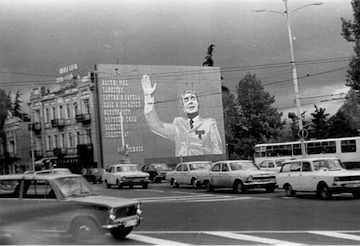This section covers the Brezhnev era from 1964 to 1985. We will be asking why the regime resisted the reforms it desperately needed to reverse economic stagnation and the growing cynicism and disillusionment of the people? Why did the population not resist the Soviet regime openly? Is that what allowed it to survive? What was the impact of high oil prices on the Soviet economy and foreign policy? To what extent did the Soviet leadership still believe in the ideals of 1917? You will find some answers to these questions in this section, which contains extracts of my books, photographs and a video, and my suggestions about what to read. Register here to get information on accessing more materials including my responses to exam questions on these themes.

Street scene in Tbilisi
Khrushchev's programme of de-Stalinization was opposed from the start by senior Party leaders whose careers had been built as Stalin's loyal servitors. By 1964 they had had enough of him. Read more...
Brezhnev emerged as primer inter pares of the colourless regime that replaced Khrushchev. Read more...
Despite Khrushchev's economic promises, shortages of basic household goods became a permanent reality as the Soviet economy stagnated during the 1960s. Read more...
One third of all baked goods in the country were made from foreign cereals. Cattle production was totally dependent on imported grain. Read more...
High oil prices also financed an eight-fold increase in military spending under Brezhnev's rule. By 1982, the military budget consumed approximately 15 per cent of the country's GNP. Read more...
The Beatles were illegal in the Soviet Union but their music recorded from Western radio stations and passed around on tapes. Read more...
Many people were disenchanted with the Soviet system. But few were brave enough to join the dissidents or oppose it openly. Read more...
These images tell us about Soviet Russia in the 'Era of Stagnation'. Read more...
Here are some exam-like questions. Read more...
A recording of a lecture/class about these themes using primary documents. Read more...
A list of further reading. Read more...

